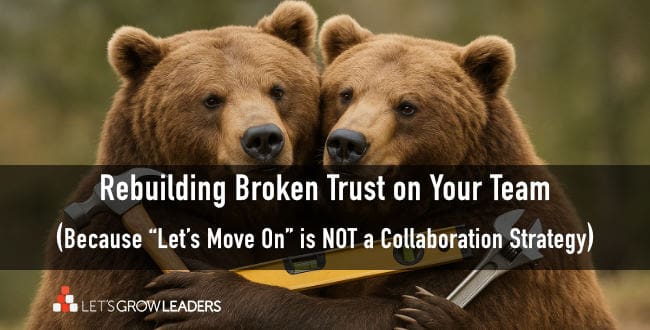3 Communication Mistakes That Sabotage Your Influence and Impact
When it comes to having better influence at work, words matter.
Of course, WHAT you say will instantly influence your credibility and impact.
But, what’s REALLY tragic is to see well-intentioned leaders with great ideas getting talked over or ignored, because of HOW they contribute.
Subtle word choice makes all the difference.
Note: If you prefer a video version of these communication mistakes, article click here for a special edition of Asking for a Friend from Geneva Switzerland.
Jane’s story
We once coached “Jane” a woman executive (she, her, hers), the only member of an all-male, executive team (he, him, his).
“Jane” was frustrated that her voice wasn’t being heard.
Jane’s boss, the CEO. was also frustrated that Jane, “lacked confidence.”
Was there some bias going on? You bet.
No question, we had to address that.
But you know what else was happening nearly every time she spoke up? Weak words sabotaged her influence.
By changing the words surrounding her ideas, her ideas suddenly gained traction, and she had a seat at the table.
3 Communication Mistakes That Sabotage Your Leadership Influence at Work
Let’s talk about three communication mistakes that sabotage your influence at work and what to say instead.
1. Pre-Apologies
There’s no question that self-deprecating humor has a place at work. In fact, we often notice some of the most successful leaders in our leadership programs using self-deprecating humor brilliantly.
Poking a bit of fun at yourself and allowing others to have a good laugh at your expense can do wonders to break the ice, particularly if you’re the one with more position power.
And, of course, REAL apologies are vital in building trust, influence, and connection. If you screw up, admit it.
But, pre-apologies where you apologize for an idea you’re about to present, scream, “Don’t listen to me, wait for the next guy. I’m sure his idea will be better.”
It’s so sad to watch a manager with a great idea start with a pre-apology and then wonder why their voice isn’t heard.
Examples of Pre-Apologies
“I’m usually wrong about such things, but …”
“This is probably a bad idea …”
“In my feeble little mind …”
“In terrible at math, but …”
Note: If you are really terrible at math, double-check or get some help. But our experience is most people who start with “I’m terrible at math” have a gut instinct that tells us something is wonky on a spreadsheet or in a presentation even faster than the best math geek.
What to say instead:
“I have an idea …”
“In my experience …”
“Great thoughts, have you also considered?”
“Can we just double-check the numbers? Can you please walk us through how you got to that?”
2. Selling Past the Close
Back in my early HR days at Verizon, I (Karin) was really excited about a new mentoring program we had developed, but I had to convince the operations leadership that the time was right. I had carefully crafted my argument and all the reasons why we needed this now.
Three minutes in, the senior vice president of sales I was meeting with said “yes.”
But, I hadn’t yet shared all my talk points or data. So, I kept talking sharing my carefully crafted pitch. He quickly interrupted and shared, “Karin, you’re selling past the close.”
If you want better influence, know when to stop talking.
What to say instead:
“Great. Glad you agree. Game on. Here’s what I recommend we do next.”
3. Hedging
When I think of “hedging words,” I think of the scarecrow from the Wizard of Oz. “Well we could go this way, but we could also go that way.”
You present a perfectly good idea, and before people can respond you quickly jump in with all the alternatives as you waffle a bit about your recommendations.
What to say instead:
It’s perfectly reasonable to concisely show your work, and explain the alternatives you considered. If you want more influence you should also have a point of view.
“I carefully considered these three alternatives. And, this is why I recommend we go this way.”
Start Here to Be a More Influential Communicator at Work
It’s easy to fall into the trap of using these derailing words, and not even notice it. The easiest way to know is to ask for feedback from someone you trust. “I’m working on improving my communication to have more influence at work. If you see me starting my sentences with a pre-apology, would you let me know?”
Or you can even record one of your virtual meetings, play it back and watch for patterns.
Your turn:
What communication mistakes have you seen sabotage influence at work?
See Also: 9 Phrases that Immediately Expose Weak Leaders For Who They Are
How to Be a More Courageous Manager
Psychological Safety or More Courage? What Your Team Needs Now
Leadership Skills: 6 Competencies You Can’t Lead Without
Executive Presence in a Virtual World: What Matters Now







I used to really enjoy coming to Karin and David’s website until I saw them contributing to the nonsense that is personal pronoun specification. All credibility gone. Your work to bring clean water to Cambodia speaks to your concern for those in need in our world and I commend you for making those efforts known. Good luck to you.
Hi Vance. We’re sorry to see you go. We do believe in the importance of inclusive leadership and enabling and supporting that conversation in a variety of ways. Thanks for your comment about the Winning Wells. That is a very important part of our work as well. Good luck in your leadership journey.
Similar to hedging is when leadership has a difficult time making a decision. Yes, there will be mistakes and decisions may not turn out right. But when the decision is many months in the making, the length of time adds road blocks to progress and success. While this is not quite hedging, it is a leadership red flag – when decisions are not made. The root cause? Probably a fear of failure (internal) and a fear of reprimand (external). Goes back to the need for an environment that is ok with decisions, ok with risks, and ok with the opportunity of progress and success.
Thanks so much, David. It’s funny that you should mention that. I’m about to record an “Asking For a Friend” on this very topic as well as address this in a new Courageous Cultures program we are building. Here’s some writing I did a while back about working with an indecisive manager. https://letsgrowleaders.com/2018/12/13/indecisive-boss/